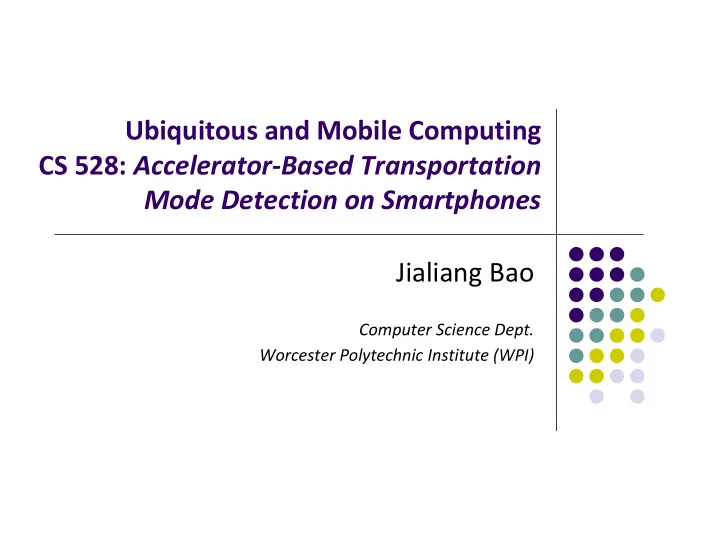

Ubiquitous and Mobile Computing CS 528: Accelerator ‐ Based Transportation Mode Detection on Smartphones Jialiang Bao Computer Science Dept. Worcester Polytechnic Institute (WPI)
Main Idea and alternatives Main Idea: Tracking transportation behavior of individuals Detect whether the user is moving How the user move (bus? Train? Or walk.) Previous work use Accelerometer-based GPS: technique 1. High power 1. Low power consumption consumption 2. Measure human behavior 2. Satellite problem directly 3. Not accurate 3. Contain high detailed information
What is Accelerometer? Challenge? https://www.youtube.com/watch?v=i2U49usFo10 https://www.youtube.com/watch?v=Faxv0uFtuwI Challenge : Extract irrelevant information about movement, e.g, gravity, user interaction and noise.
Preprocessing and Gravity Estimation 1. Low-pass filter to remove jitter. 2. Aggregate measurement using a sliding window with duration of 1.2 seconds 3. Project the sensor measurements to a global reference frame Limitations: 1. Assume noise and observed accelerometer patterns uncorrelated 2. Orientation of sensors may suddenly change
To solve it, a new algorithm proposed Dynamically adjust the variance threshold according to movement pattern Allow the variance threshold to increase until a hard upper threshold is reached Exceed threshold, use Mizell technique to calculate Gravity
What is Segment? Each activity has a duration of several minutes.
Feature Extraction Frame based feature Peak-based features Segment based features
Classification � Adaptive Boosting Iteratively learn weak classifiers that focus on different subsets of the training data and to combine these classifiers into one strong classifier � Segment – based classification 1. Aggregate classification results of frame and peak features over an observed segment 2. Compute the classification result of the segment based features � Kinematic Motion classifier Utilize frame-based accelerometer features extracted from each window to distinguish between pedestrian and other modalities � Stationary classifier Use both peak features and frame based features to tell stationary or other modes � Motorized classifier Used to distinguish between different motorized transportation modes.
Performance Evaluation 1. Accuracy of transportation mode detection 1. power consumption
Performance Evaluation 3 Generalization performance of classifiers 4 Latency of the detection (Not good)
Thank you!
Recommend
More recommend